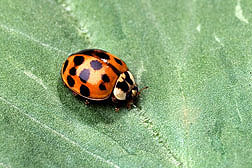Science Update
Why a North American Tree Is Invasive in in Europe
Black cherry trees are native to the United States, but they now also thrive in Europe, where they are considered an invasive species. In the United States, damping-off disease, which is caused by the soil pathogen Pythium, keeps black cherry trees in check. Researchers collected soil randomly around black cherry trees in more than 20 forests throughout their range in the United States and nearly 20 forests throughout Germany, France, Belgium, and The Netherlands. They then tested the virulence of Pythium isolates from each sample and used DNA sequencing to identify each isolate.
They found that some nonaggressive Pythium types were common in both ranges, but aggressive types were found only among samples obtained in the United States. Additional research indicates that the density and distribution of black cherry trees is significantly greater in European forests than in U.S. forests.
These combined findings suggest that black cherry trees in Europe are invasive partly because these new populations have escaped virulent Pythium species.
Kurt O. Reinhart, USDA-ARS Livestock and Range Research Laboratory, Miles City, MT 59301; (406) 874-8211.
|
|
Catnip Compound Curbs Asian Lady Beetles
At certain times of the year, the multicolored Asian lady beetle, Harmonia axyridis, comes inside—sometimes in large swarms—to escape the cold. It’s an unwelcome guest because when it feels threatened, it releases a nontoxic yellow liquid that smells foul and produces stains. But in one study, researchers found that almost all adult male and female lady beetles turned away or otherwise tried to avoid the catnip compound nepetalactone—a substance that also shows promise for repelling some cockroaches, flies, termites, and mosquitoes.
These findings could lead to a combined “push-pull” control method, which would use repellents to discourage lady beetles from entering buildings and traps to lure and capture the insects so that they can be released elsewhere. This would allow humans to continue to benefit from the beetle’s efficient predation of aphids, scales, and other soft-bodied arthropods that damage plants.
Eric W. Riddick, Biological Control of Pests Research Unit, Stoneville, MS 38776-0067; (662) 686-3646.
Kamal R. Chauhan, Invasive Insect Biocontrol and Behavior Laboratory, Beltsville, MD 20705; (301) 504-5166.
Developing Attractants, Repellents for a Cattle Pest
The stable fly can make cattle miserable, and producers have had only limited success in using traditional insecticides against the pest. Now researchers are identifying aromatic compounds that attract and repel stable flies and have used two compounds found in catnip to develop a control strategy.
In lab tests, the two compounds—ZE-nepetalactone and EZ-nepetalactone—discourage even starved stable flies from biting cattle and feeding on their blood, providing effective protection more than 98 percent of the time. The same compounds have a 95-percent success rate in discouraging female stable flies from laying their eggs. In addition, carbon dioxide and some compounds in manure and bacteria elicit antenna responses from stable flies that are similar to the flies’ response to pheromones, which suggests that these compounds might be used as attractants for pest management.
These findings are important steps in developing biobased control tools and improving sustainable stable fly management.
Junwei Zhu, USDA-ARS Agroecosystem Management Research Unit, Lincoln, NE 68583-0938; (402) 472-7525.
Water Hardness Plays a Role in Removing Bacteria from Chicken Skin
Water used in commercial poultry-processing facilities can play a major role in the quality of the meat produced. Researchers have found that soft water is more effective than hard water in removing bacteria from broiler chicken skin. Hard water has higher concentrations of dissolved minerals like calcium and magnesium, and water is softened by removing these minerals.
Scientists compared how well very hard, moderately hard, and soft water rinsed away different bacteria—including Campylobacter, Staphylococcus, and Pseudomonas—from the skin of broiler chicken carcasses. They found that soft water removed up to 37 percent more bacteria than the other two water types. The effectiveness of sanitization procedures to remove microorganisms from carcasses during processing is affected by several water-quality variables, including pH, ammonia concentration, microbial contamination levels, and hardness.
These findings suggest that poultry processors might want to more closely monitor water hardness and its impact on carcass processing.
Arthur Hinton and Ronald Holser, USDA-ARS Richard B. Russell Agricultural Research Center, Athens GA 30605; (706) 546-3621 [Hinton], (706) 546-3361 [Holser].
"Science Update" was published in the February 2010 issue of Agricultural Research magazine.







